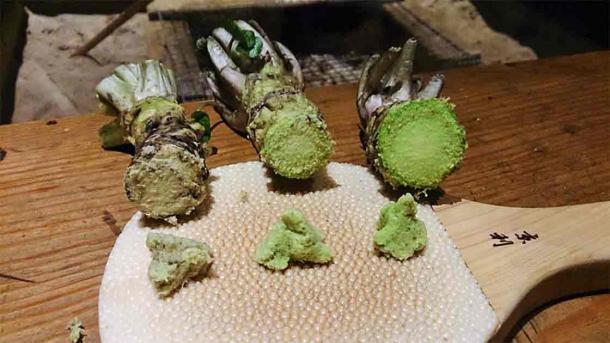
Wasabi Is Innovative ‘Green’ Solution for Preserving Ancient Papyrus
Researchers have discovered a novel, environmentally friendly method for preserving bio-deteriorated painted archaeological papyri using wasabi. The study, led by Hanadi Saada and her team, explored the efficacy of wasabi vapors in eradicating microbial growth that deteriorates papyrus artifacts, which have been of significant historical and cultural importance, particularly in ancient Egypt.
Papyrus, utilized extensively throughout history for various purposes including writing material, boats, and basketry, is prone to biodeterioration, primarily due to fungal growth. This not only affects the structural integrity of these artifacts but also leads to aesthetic damage. Traditional methods for controlling this deterioration have included mechanical, physical, and chemical treatments, each with varying degrees of success and potential side effects, including toxicity and further damage to the artifacts.
- 3,600-Year-Old Surgical Treatise Reveals Secrets of Egyptian Medical Knowledge
- Experts Finally Decode 2000-year-old ‘Mirror Writing’ Papyrus

Wasabi in root and paste form, usually served in sushi restaurants. (MIURA, Yuji/ CC BY-SA 4.0)
In an unprecedented study, published in the Journal of Archaeological Science, Saada and her colleagues investigated the use of wasabi, known scientifically as Wasabia japonica, a plant famous in Japanese cuisine, which has shown potential due to its fungicidal properties. The study specifically examined the interaction of wasabi with different pigments used in painted papyrus, employing a variety of microbiological, mechanical, physical, and chemical evaluations.
The results were promising: treatment with wasabi vapors for 72 hours eradicated microbial growth in both painted and non-painted papyrus samples with a 100% inhibition efficiency. Notably, the treatment improved the tensile strength of the papyri by 26% without causing any noticeable change to the color or surface morphology of the artifacts. Furthermore, FT-IR and EDX analyses indicated negligible chemical changes, underscoring the non-invasive nature of the treatment.
- A Test for the Taste Buds: The 7 Weirdest Foods in History
- Unearthing the Ancient Roots of Vegetarianism
This innovative method not only offers a safer, greener alternative for the preservation of archaeological papyri but also ensures the longevity of these invaluable artifacts without compromising their integrity. The researchers' findings suggest a significant shift towards green conservation methods, emphasizing the importance of sustainable practices in archaeology and heritage preservation.
The implications of this study extend beyond papyri conservation, potentially influencing preservation techniques for a wide range of organic archaeological materials. As the research progresses, the archaeological community watches closely, hopeful that this green solution marks a new era in the conservation of our global heritage.
Top image: Example of a brightly painted antique papyrus, as could benefit from wasabi’s preservative qualities. Source: Thomas Sztanek/Adobe Stock
By Gary Manners
References
Saada, H., Othman, M., Attia, N., Salah, M., Mohalhal, H., Matsuda, Y., & Khaleil, M. (2024). A safely green treatment of bio-deteriorated painted archaeological papyri by Wasabi. Journal of Archaeological Science, 105936. https://doi.org/10.1016/j.jas.2024.105936















